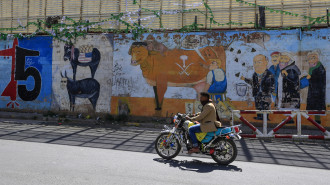Meeting the queen of Arab kitsch
Rana Salam is not just a leading Arab graphic designer - she revolutionised the idea of Arab folk and street art.
Rana was born to the pioneer Lebanese architect Assem Salam and Josephine Bisharat from Jerusalem.
Her educational journey started at the International College Beirut, which led her to The Royal College of Art in London, where she engrossed herself in the study of visual and graphic design.
Her college thesis, which resulted in a commission to design the windows displays at Harvey Nichols, was the major turning point in her career. The project led to her amazing graphic book: "The Secret Life of Syrian Lingerie."
During her London years, Rana was vexed by the orientalism of the West and the false notion that Arabs were a sexually repressed society.
During a visit to the Hamadieh Grand Bazaar in Damascus, she was intrigued by the interestingly kinky Syrian underwear displayed in the glass cases there.
With creativity matched with a wild imagination, Rana harnessed those images to show the West that Arabs do indeed have sexual expression and are not sexually stunted.
To further combat Orientalism and the clichéd symbols of the Middle East - "the camel and the fez", she says - Rana reinvented the image of the ultimate Arab diva, Oum Kulthoum.
| The solutions people created out of desperation and out of nothing were fascinating. - Rana Salam |
Like the famous Rolling Stones' mouth and tongue logo, Rana stylised Oum Kulthoum's lips and swapped her sunglasses for Alexander Wang's Zipper shades by Linda Farrow.
She felt Arab symbols were neglected and needed to have light shed on them to celebrate the artists from 1950s, 1960s and 1970s. Rana focused on cinematic Arab icons from The Golden Age - Sabah, Tahia Karioka, Rushdie Abaza, Omar Shareef and Faten Hamama.
She also included other street Arab icons in her work, from chewing gum to dabke to Egyptian movie billboards.
Her online boutique, Mishmaoul, and her shop in Beirut are depots for all her amazing designs and ideas. Rana's main inspiration, she says, is "the zeitgest". Her motto? "To change the perception of the Middle East through the power of design." Al-Araby met Rana Salam, and, just for you, here's part of our conversation.
How important do you think the zeitgest is to your inspiration for your design and your philosophy as an artist? And how would you respond to Ezra Pound, who said "artists are the antenna of the human race"?
Rana Salam: The zeitgest is an inspiration, as it goes against what people believe - and it is quite shocking when things are revealed. Ezra's quote is absolutely spot on, as artist have visions and power to make them happen.
| Beirut proved to be very fruitful and enriching. - Rana Salam |
Can you tell us about your MA thesis at the Royal College of Art in London? How did it get commissioned by Harvey Nichols? And, most importantly, how did that thesis propel and influence your career?
The thesis was entitled Beirut: Design Under Civil War. It was the beginning of what you describe as the tip of the iceberg. I was documenting Lebanese street culture and how it survived during the civil war. The solutions people created out of desperation and out of nothing were fascinating. The spontaneity, humbleness and freshness was beautiful.
From this study and observation, I was able to capture a unique visual language which I was able to translate into my work and sell it to the upmarket.
You lived and worked in London for 25 years. Your designs were associated with big brands like Harvey Nichols and Paul Smith. Can you tell us how those collaborations came about? Why did you move to Beirut after 25 years? How was the transition?
The collaboration with the big brands happened by simply knocking their doors and selling them my vision. To them it was exotic and fresh and new.
Soon after, I created a signature style - which was very evident in the work I did for the restaurant, Comptoir Libanais.
But after 25 years I decided to move back - on purely an emotional and irrational decision. One of the best decisions I ever made. Beirut proved to be very fruitful and enriching.
Orientalism, Orientalism, Orientalism. One of your missions as an Arab artist is to combat Western stereotypes and misconceptions about the Middle East. What was the incident that opened your eyes and soul to that? How you would respond to the visual design on Camel Cigarettes that has a camel and pyramid and says 'Turkish and American Blend'?
It was when I saw how the West was very smart at capitalising on their own symbolic commodities such as the red London bus, the black cab and the British flag. They were proud and sold their country through the power of graphics and packaging. They knew how to make themselves desirable and cool.
Can you define the term 'kitsch' to our audience? Can you tell us how you invented the Oum Kulthoum symbol? How did other Arab designers steal your idea?
I did not invent the Oum Kulthoum symbol. I simply recreated the look and repositioned her. She used to be on cinema posters and now you find her on my kitchen towels used in many people's homes.
Other Arab designers got influenced by my work and copied. This is what happens when you are a leader in the market and you set a trend.
What is your advice to the emerging Arab youth who want to pursue graphic design as a career? What is your advice to female artists, specifically?
| Female artists? Always have something of your own. - Rana Salam |
My advice to emerging Arab designers is to look within and celebrate what we have.
Female artists? Always have something of your own.
Besides kitsch, orientalism, and combining the spirit of East and West in your designs, what else inspires Rana Salam? What gets Rana Salam going every day?
What inspires me every day - despite my daily morning run - is looking over the Mediterranean sea and the noise, food and people of this city. All the madness that I see every day inspires me. It's like a 24-hour Fellini movie.
Beirut is city of tremendous contrasts, politically, socially and culturally. How does that inspire you? How did seep into your art?
The wit and sense of humour of street culture has seeped into my work dramatically.
There is a lot of laughter in my designs and the things I spot are very unexpected and have incredible stories behind them.
Whenever you buy something from my shop, you are buying a story.







 Follow the Middle East's top stories in English at The New Arab on Google News
Follow the Middle East's top stories in English at The New Arab on Google News


